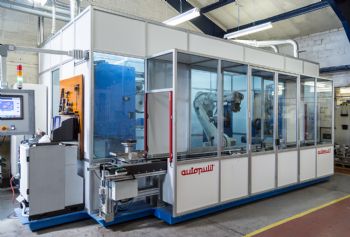
A privately owned 16-employee business, Watford-based Hiretech has evolved from being a tool-hire company to a world leader in the design and manufacture of floor sanders and steam wallpaper strippers.
The business was started in the 1950s; by the mid-1980s, it had grown significantly with representation in Homebase stores across the country.
However, it had seen a change in the tool-hire business, which is why it began the move to product manufacture and the development of a series of ‘professional’ floor sanders.
These were sold to the hire sector, and Hiretech now claims a 95% share of the UK market, supplying businesses such as HSS, Travis Perkins and Jewson.
Manufacturing success saw Hiretech withdraw completely from tool hire in 1998 to focus on manufacturing and grow global sales, with the opening of distributors in America and Australia.
Driving this was a willingness on the part of the company’s current managing director, Mark Rogers, to invest in manufacturing technology — as evidenced by a trio of high-end four-axis machining centres, which provide much more capacity than Hiretech needs on a daily basis.
Manufacturing manager Ron Putta says: “We always start at the top end of the specification list when looking at new equipment and work from there; and being a privately owned business, we can make investment decisions that may at first seem illogical to others.

Our machining centres are a prime example; while we have a level of redundancy, we also have a high level of flexibility and can swap work around — as and when required — between machines.
We also aim to maximise the level of control we have over our production— hence our recent investment in an Autopulit robot grinding, brushing and polishing cell from Ellesco. We can now do all the polishing we need in-house.”
Automated finishing
The Autopulit cell from Christchurch-based Ellesco Ltd (
www.ellesco.co.uk) fully automates the grinding, brushing and polishing of a number of components on Hiretech’s floor sanders.
It features an ABB robot, automated part loading with a ‘chip-reading’ system that identifies which part is being picked up by the robot and selects the relevant program; this capability allows a mixture of parts to be run at any one time.
There are three belt-type grinding stations (each with a different grade of abrasive grit), a brushing station for cleaning up certain areas of the castings and a double-headed polishing unit with oscillation and the automatic application of polishing compound via spray guns.

While many OEMs see sub-contract as a way to reduce cost and eliminate in-house manufacturing, Hiretech takes the opposite view, and the company’s programme of investment is allowing more than 80% of production to be undertaken in-house.
While Hiretech makes investment freely, it says this is always as a result of detailed evaluation, with the Autopulit cell a case in point. The possibility of automated polishing was first considered some years ago at a
MACH exhibition; two years later (at the following
MACH), Mr Putta spoke to Ellesco about the ways in which robots could improve productivity.
“It was definitely a project on the ‘slow burner’, but we recognised issues surrounding our external suppliers of polishing; they were becoming unreliable — then one went out of business.
“When our American distributor won significant business from Home Depot, our deliveries of polished parts began to drift. We did consider bringing manual polishing in-house, but ruled that out due to the difficulty of finding additional staff with the required skills.
“We also had concerns about the work being arduous and dirty — plus there were considerations regarding health and safety. The idea of robot polishing seemed particularly attractive, and we started serious discussions with Ellesco and Autopulit.”
System development
The next stage was for Autopulit to fine-tune a process to suit Hiretech’s particular requirements; these included the processing of raw castings, which can vary in size.
The solution was to re-engineer the belt stations with a floating head and pressure sensing; when excess material is encountered, this allows the contact pressure to be adjusted automatically, ensuring consistent processing and surface finish.
One aspect of bringing sub-contract polishing in-house was the steep learning curve, not only in operating the system but also in understanding what Mr Putta describes as the ‘black art’ of polishing.
“With such a lean team here at Hiretech, we have to include people in our plans, get them involved and give them ownership of processes.”
With the Autopulit cell, this fell to machine operator Sandor Toth, who was more familiar with metal cutting on Hiretech’s machining centres and sliding-head lathes.
As part of his introduction to the cell and polishing, Mr Toth spent two weeks working with Autopulit’s engineers on-site at Hiretech, plus three days on a robot operation course at ABB, learning the basics of programming.

He said that, while the teach-type programming of the robot is very different to programming a conventional CNC machine with fixed axes, “the system makes it very easy to learn. All that was required then was to understand the intricacies of polishing.”
The effectiveness of automated finishing is evidenced by the time taken to process the largest casting made by Hiretech using the Autopulit cell; from loading to unloading, the entire polishing process is completed in just 10min. Mr Putta estimates that manual polishing took the previous sub-contractor 1hr, plus there was the additional cost of transport and work in progress.
“The automation of the process has eased the transition to polishing in-house; and while we still need an even better understanding of the polishing process with regard to compounds and grits, for example, the robot plus automation has had a major impact on work-flow and productivity — plus we have gained an additional skills set.”
In conclusion, Ellesco’s senior sales engineer, Colin Moon, said: “The team at Hiretech fully embraced the Autopulit technology and quickly recognised what it could bring to their business in terms of production control, efficiency and cost savings, as well as overall component quality and consistency.”